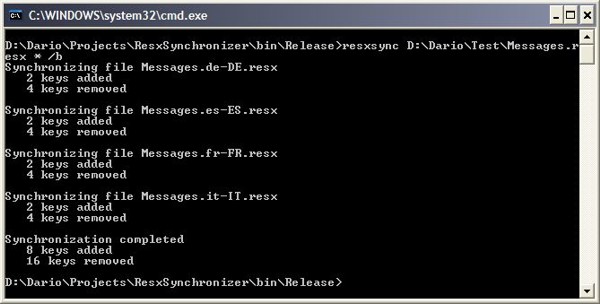
Introduction
An ASP.NET project I'm working on requires localization in different languages. It's nice to use .NET Resource files (.resx), because they are really integrated with the framework and you do not have to worry about explicitly managing the resources. Resource files are, though, really un-maintainable. When you edit the resource files in Visual Studio, ore use the "Generate Local Resources" function, it only updates the default language resources. For example, the file Default.aspx.resx, and not all the translated files, for example, Default.aspx.it-IT.resx. This is obviously a big problem, since you have to update them one by one, manually. RESX Synchronizer allows you to synchronize resource files, adding new keys and removing the deleted ones. It also processes a set of resource files, the "master" file, and all its translated "brothers".
How it Works
This tool uses the two classes System.Resources.ResXResourceReader and System.Resources.ResXResourceWriter, contained in the assembly System.Windows.Forms.dll. These classes allow to read and write .resx files, including comments.
We'll use the name of "source file" to indicate the "master" resource file, for example, Default.aspx.resx, and the name of "destination file" to indicate a "brother" resource file, for example, Default.aspx.it-IT.resx, which must be synchronized. The tool must perform two operations in order to get the files synchronized:
- Compare the two files, finding new keys to be added to the "destination" file.
- Compare the two files, finding deleted keys to be removed from the "destination" file.
The core of the tool is the class Synchronizer. Its code is reported here, and the concepts behind it are explained below.
public class Synchronizer {
string sourceFile, destinationFile;
public Synchronizer(string sFile, string dFile) {
sourceFile = sFile;
destinationFile = dFile;
}
public void SyncronizeResources(bool backup,
bool addOnly, bool verbose,
out int added,out int removed) {
added = 0;
removed = 0;
if(backup) {
string destDir = Path.GetDirectoryName(destinationFile);
string file = Path.GetFileName(destinationFile);
File.Copy(destinationFile, destDir +
"\\Backup of " + file, true);
}
string tempFile = Path.GetDirectoryName(destinationFile) +
"\\__TempOutput.resx";
MemoryStream sourceStream = new MemoryStream(),
destinationStream = new MemoryStream();
FileStream fs;
int read;
byte[] buffer = new byte[1024];
fs = new FileStream(sourceFile, FileMode.Open,
FileAccess.Read, FileShare.Read);
read = 0;
do {
read = fs.Read(buffer, 0, buffer.Length);
sourceStream.Write(buffer, 0, read);
} while(read > 0);
fs.Close();
fs = new FileStream(destinationFile, FileMode.Open,
FileAccess.Read, FileShare.Read);
read = 0;
do {
read = fs.Read(buffer, 0, buffer.Length);
destinationStream.Write(buffer, 0, read);
} while(read > 0);
fs.Close();
sourceStream.Position = 0;
destinationStream.Position = 0;
ResXResourceReader source = new ResXResourceReader(sourceStream);
source.UseResXDataNodes = true;
ResXResourceReader destination =
new ResXResourceReader(destinationStream);
destination.UseResXDataNodes = true;
if(File.Exists(tempFile)) File.Delete(tempFile);
ResXResourceWriter writer = new ResXResourceWriter(tempFile);
foreach(DictionaryEntry d in source) {
bool found = false;
foreach(DictionaryEntry dd in destination) {
if(d.Key.ToString().Equals(dd.Key.ToString())) {
found = true;
break;
}
}
if(!found) {
ResXDataNode node = d.Value as ResXDataNode;
writer.AddResource(node);
added++;
if(verbose) {
Console.WriteLine("Added new key '" + d.Key.ToString() +
"' with value '" +
d.Value.ToString() + "'\n");
}
}
}
if(addOnly) {
foreach(DictionaryEntry d in destination) {
ResXDataNode node = d.Value as ResXDataNode;
writer.AddResource(node);
}
}
else {
int tot = 0;
int rem = 0;
foreach(DictionaryEntry d in destination) {
bool found = false;
tot++;
foreach(DictionaryEntry dd in source) {
if(d.Key.ToString().Equals(dd.Key.ToString())) {
found = true;
}
}
if(found) {
ResXDataNode node = d.Value as ResXDataNode;
writer.AddResource(node);
rem++;
}
else if(verbose) {
Console.WriteLine("Removed deleted key '" +
d.Key.ToString() +
"' with value '" +
d.Value.ToString() + "'\n");
}
}
removed = tot - rem;
}
source.Close();
destination.Close();
writer.Close();
File.Copy(tempFile, destinationFile, true);
File.Delete(tempFile);
}
}
The two operations described above are implemented in the two foreach cycles. The first one iterates over the source keys, searching for keys with the same name in the destination. If no key is found, then the current key in the source file is new, and must be added to the output (destination) file. The second cycle iterates over the destination keys, searching for keys with the same name in the source. If a key with the same name is found in the source file, then the key is still needed, and then it must be copied to the output. If no key is found, then that key has been deleted and therefore it is not copied to the output.
The Synchronizer class is also able to:
- Create a backup copy of the destination file before modifying it
- Add only new keys, without removing the deleted keys
- Display in the console each added and removed key
- Return to the caller the number of added and deleted keys
The Command-Line Tool
The Synchronizer class has been wrapped into a command-line tool, which parses the parameters and performs the synchronization using the class. The code of this utility is really simple, and therefore does not need to be reported.
Usage of the Command-Line Tool
Since the tool is still in a development stage, I don't want to report here the usage instructions which might be obsolete in a few days, so I point you to the official page of the tool, available at this address.
History
- 2006/10/12 - Version 1.1: support for comments added
- 2006/09/25 - Initial version
 General
General  News
News  Suggestion
Suggestion  Question
Question  Bug
Bug  Answer
Answer  Joke
Joke  Praise
Praise  Rant
Rant  Admin
Admin 







 and now I'm only playing a little when I need in my spare time.
and now I'm only playing a little when I need in my spare time.